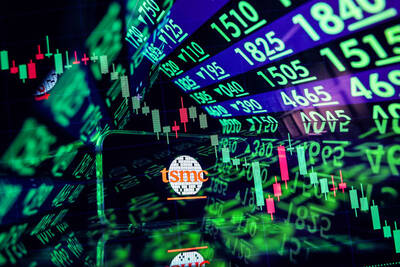The government’s business climate monitor last month was “red” for the first time in a decade, as the economy is heating up due to strong demand for tech and non-tech products, as well as a low comparison base last year.
The monitor gained 3 points to 40, the highest in 32 years. Officials shrugged off bubble and inflation concerns, saying the “red” signal came on the back of solid economic fundamentals.
“Robust exports, private investment and consumer spending accounted for the boom that had nothing to do with bubbles or drastic inflation,” National Development Council (NDC) Deputy Minister Kao Shien-quey (高仙桂) told a media briefing.

Photo: CNA
The council uses a five-color system to portray the nation’s economic state, with “green” indicating steady growth, “red” suggesting overheating and “blue” signaling a recession. Dual colors indicate a transition.
Many have voiced concerns about potential economic bubbles, as COVID-19 infections remain high in many parts of the world, while some research bodies have warned that central banks could reverse loose monetary policies early to rein in inflation risks.
The government has been closely watching international raw material price movements and believes that the price hikes so far are benign, Kao said.
Although Taiwan’s GDP growth this year is forecast to reach 4.64 percent, the central bank last week said it would stand by its current accommodative monetary policy in line with its global peers for fear that a rate hike would attract hot money.
NDC Minister Kung Ming-hsin (龔明鑫) had earlier told lawmakers that the government might consider tightening measures if the boom extends into the second half of this year.
Isolated “red” signals pose no threat, Kung said.
The COVID-19 pandemic started in January last year, weakening economic growth over the following several months, but things started to improve in the second half.
The index of leading indicators, which aims to portray the economic situation for the next six months, picked up 0.52 percent to 106.69, as gauges on imports of semiconductor capital equipment, manufacturing business confidence and labor entry rates all pointed upward, the council said.
However, readings on export orders and new construction floor areas slipped from one month earlier due to unfavorable holiday effects.
The index of coincident indicators, which reflects the current economic state, grew 1.35 percent to 106.8, with markers such as power usage, retail sales, manufacturing sales and restaurant revenue all gaining value due to business improvement, the council said.
Non-farm payrolls and exports declined from a month earlier, as there were fewer working days last month.
Major tech firms are upbeat about their business this month and beyond, lending support to the economic boom.

Taiwan’s long-term economic competitiveness will hinge not only on national champions like Taiwan Semiconductor Manufacturing Co. (TSMC, 台積電) but also on the widespread adoption of artificial intelligence (AI) and other emerging technologies, a US-based scholar has said. At a lecture in Taipei on Tuesday, Jeffrey Ding, assistant professor of political science at the George Washington University and author of "Technology and the Rise of Great Powers," argued that historical experience shows that general-purpose technologies (GPTs) — such as electricity, computers and now AI — shape long-term economic advantages through their diffusion across the broader economy. "What really matters is not who pioneers

In a high-security Shenzhen laboratory, Chinese scientists have built what Washington has spent years trying to prevent: a prototype of a machine capable of producing the cutting-edge semiconductor chips that power artificial intelligence (AI), smartphones and weapons central to Western military dominance, Reuters has learned. Completed early this year and undergoing testing, the prototype fills nearly an entire factory floor. It was built by a team of former engineers from Dutch semiconductor giant ASML who reverse-engineered the company’s extreme ultraviolet lithography (EUV) machines, according to two people with knowledge of the project. EUV machines sit at the heart of a technological Cold

Taiwan Semiconductor Manufacturing Co (TSMC, 台積電) last week recorded an increase in the number of shareholders to the highest in almost eight months, despite its share price falling 3.38 percent from the previous week, Taiwan Stock Exchange data released on Saturday showed. As of Friday, TSMC had 1.88 million shareholders, the most since the week of April 25 and an increase of 31,870 from the previous week, the data showed. The number of shareholders jumped despite a drop of NT$50 (US$1.59), or 3.38 percent, in TSMC’s share price from a week earlier to NT$1,430, as investors took profits from their earlier gains

TAIWAN VALUE CHAIN: Foxtron is to fully own Luxgen following the transaction and it plans to launch a new electric model, the Foxtron Bria, in Taiwan next year Yulon Motor Co (裕隆汽車) yesterday said that its board of directors approved the disposal of its electric vehicle (EV) unit, Luxgen Motor Co (納智捷汽車), to Foxtron Vehicle Technologies Co (鴻華先進) for NT$787.6 million (US$24.98 million). Foxtron, a half-half joint venture between Yulon affiliate Hua-Chuang Automobile Information Technical Center Co (華創車電) and Hon Hai Precision Industry Co (鴻海精密), expects to wrap up the deal in the first quarter of next year. Foxtron would fully own Luxgen following the transaction, including five car distributing companies, outlets and all employees. The deal is subject to the approval of the Fair Trade Commission, Foxtron said. “Foxtron will be